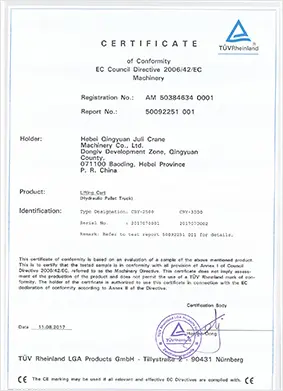


Safe Use of Chain Blocks Essential Guidelines for Workers
Chain blocks, also known as chain hoists, are indispensable tools in various industries for lifting and moving heavy loads safely and efficiently. When used correctly, they can significantly enhance productivity and safety on the job site. However, improper use can lead to serious accidents, injuries, or even fatalities. Therefore, it is crucial to understand the safe use of chain blocks to ensure the well-being of all personnel involved in lifting operations.
Understanding Chain Blocks
Chain blocks consist of a chain that wraps around a pulley system, allowing for the mechanical advantage needed to lift heavy objects. They are commonly used in construction, manufacturing, and warehouses. While they greatly simplify lifting tasks, they also require respect and understanding of their limitations and safe practices.
Inspection Before Use
Before operating a chain block, a thorough inspection is mandatory. Operators should check the following
1. Chain Condition Inspect the chain for any signs of wear, elongation, or damage. A compromised chain can lead to failure under load. 2. Hooks Ensure that the hooks are not bent, cracked, or otherwise damaged. They should be able to securely hold the load without any risk of slippage. 3. Brake Functionality Test the brake system to ensure it can hold a load without slipping. 4. Pulley Alignment Verify that the pulleys are aligned correctly and free of any obstructions.
Regular maintenance and adherence to the manufacturer’s specifications are essential to keep the chain block in optimal condition
.
Proper Lifting Techniques
1. Load Capacity Always know the maximum load capacity of the chain block before lifting. Overloading can lead to catastrophic failure. 2. Center of Gravity When lifting an object, ensure it is balanced and the center of gravity is stable. Unequal weight distribution can cause the load to swing or tip. 3. Clear Area Before lifting, check the area around the load for obstructions or personnel. Clear communication with team members is vital to ensure everyone is aware of the lifting operation.
Operator Training
Only trained and certified personnel should operate chain blocks. Proper training ensures that operators are familiar with the equipment, its limitations, and the safety protocols involved in lifting operations. Regular refreshers on safety practices can keep skills sharp and enhance safety awareness.
Emergency Procedures
Every workplace should have established emergency procedures in case of an accident or equipment failure. Operators must be trained to respond quickly and effectively to emergencies, including knowing how to safely lower a load in the event of a lift malfunction.
Conclusion
The safe use of chain blocks is paramount in preventing workplace accidents and ensuring efficient operations. By adhering to inspection protocols, understanding proper lifting techniques, ensuring operator training, and having emergency procedures in place, businesses can create a safer working environment. Organizations must prioritize safety, as it not only protects workers but also promotes productivity and efficiency. In the end, a commitment to safety with chain blocks pays dividends in both human and financial aspects. Always remember safety first translates to success in every lifting operation.



